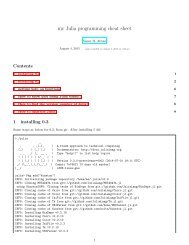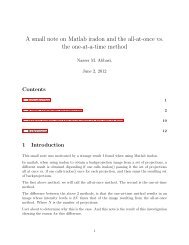Create successful ePaper yourself
Turn your PDF publications into a flip-book with our unique Google optimized e-Paper software.
Every time we take derivatives, we stop and look. For any vector that originates from the moving frame,<br />
we must apply rule (1) to it. That is all. In the above, only r needs rule (1) applied to it, since that is the<br />
only vector measure from the moving frame. Replacing ṙ p by V p and ṙ o by V o , meaning the velocity of P and o,<br />
Hence the above becomes<br />
V p = V o + ṙ<br />
and now we apply rule (1) to expand ṙ<br />
V p = V o + (V rel + ω × r) (3)<br />
where V rel is just d dt r∣ ∣<br />
relative<br />
The above is the final expression for the velocity of the particle V p using its velocity as measured by the<br />
moving frame in order to complete the expression.<br />
So the above says that the absolute velocity of the particle is equal to the absolute velocity of the base of the<br />
moving frame + something else and this something else was (V rel + ω × r)<br />
Now we will find the absolute acceleration of P . Taking time derivatives of (3) gives<br />
˙V p = ˙V<br />
( )<br />
o + ˙Vrel + ˙ω × r + ω × ṙ<br />
(4)<br />
As we said above, each time we take time derivatives, we stop and look for vectors which are based on the<br />
moving frame, and apply rule (1) to them. In the above, ˙Vrel and ṙ qualify. Apply rule (1) to ˙V rel gives<br />
˙V rel = a rel + ω × V rel (5)<br />
where a rel just means the acceleration relative to moving frame. And applying rule (1) to ṙ gives<br />
Replacing (5) and (6) into (4) gives<br />
ṙ = V rel + ω × r (6)<br />
a p = a o + (a rel + ω × V rel + ˙ω × r + ω × (V rel + ω × r))<br />
= a o + a rel + (ω × V rel ) + ( ˙ω × r) + (ω × V rel ) + (ω × (ω × r))<br />
= a o + a rel + 2 (ω × V rel ) + ( ˙ω × r) + (ω × (ω × r)) (7)<br />
Eq (7) says that the absolute acceleration a p of P is the sum of the acceleration of the base a o of the<br />
moving frame plus the relative acceleration a rel of the particle to the moving frame plus 2 (ω × V rel ) + ( ˙ω × r) +<br />
(ω × (ω × r))<br />
Hence, using Eq(3) and Eq(7) gives us the expressions we wanted for velocity and acceleration.<br />
10 Miscellaneous hints<br />
1. When finding the generalized force for the user with the Lagrangian method (the hardest step), using the<br />
virtual work method, if the force (or virtual work by the force) ADDS energy to the system, then make<br />
the sign of the force positive otherwise the sign is negative.<br />
2. For damping force, the sign is always negative.<br />
3. External forces such as linear forces applied, torque applied, in general, are positive.<br />
4. Friction force is negative (in general) as friction takes energy from the system like damping.<br />
50





